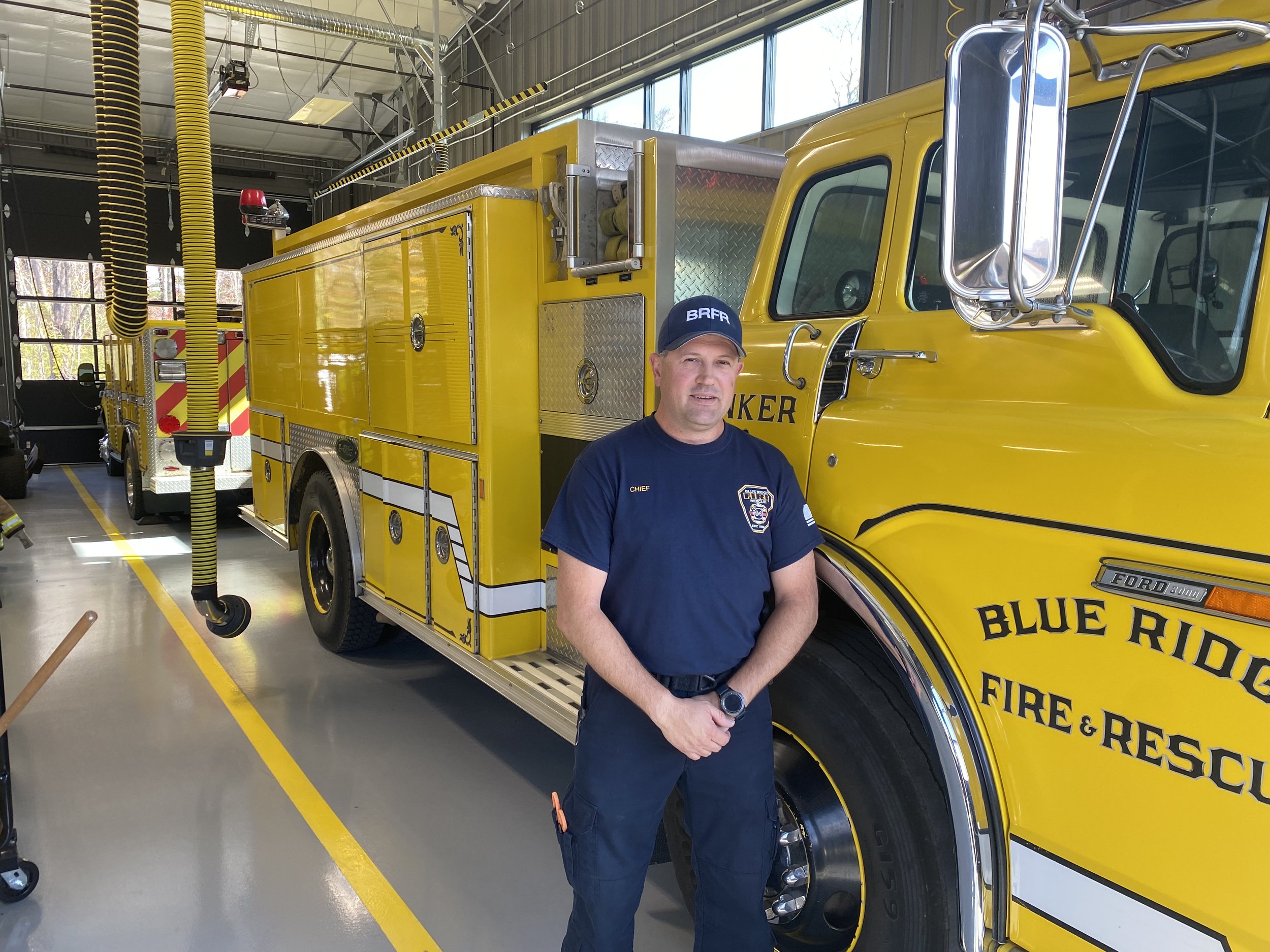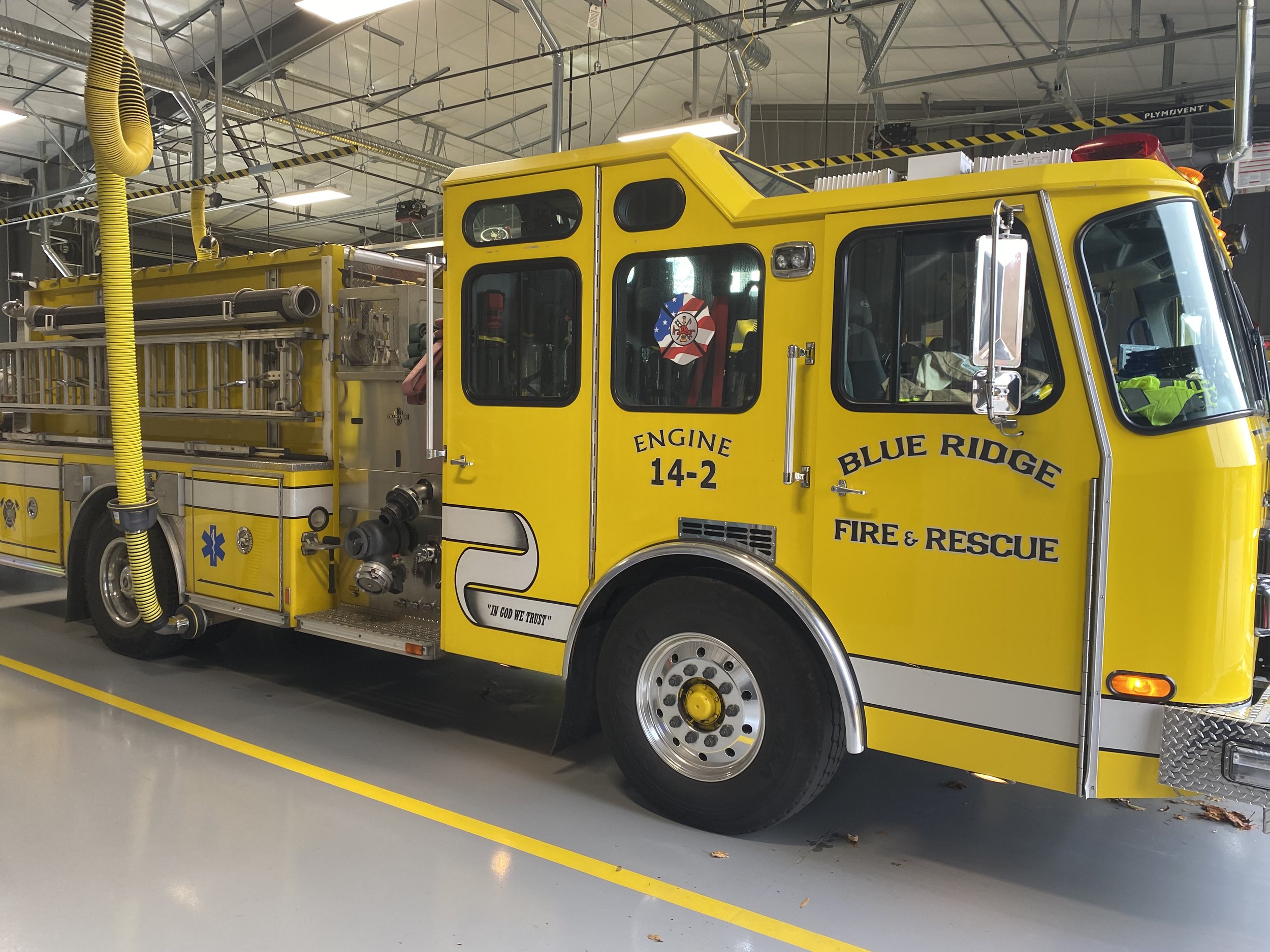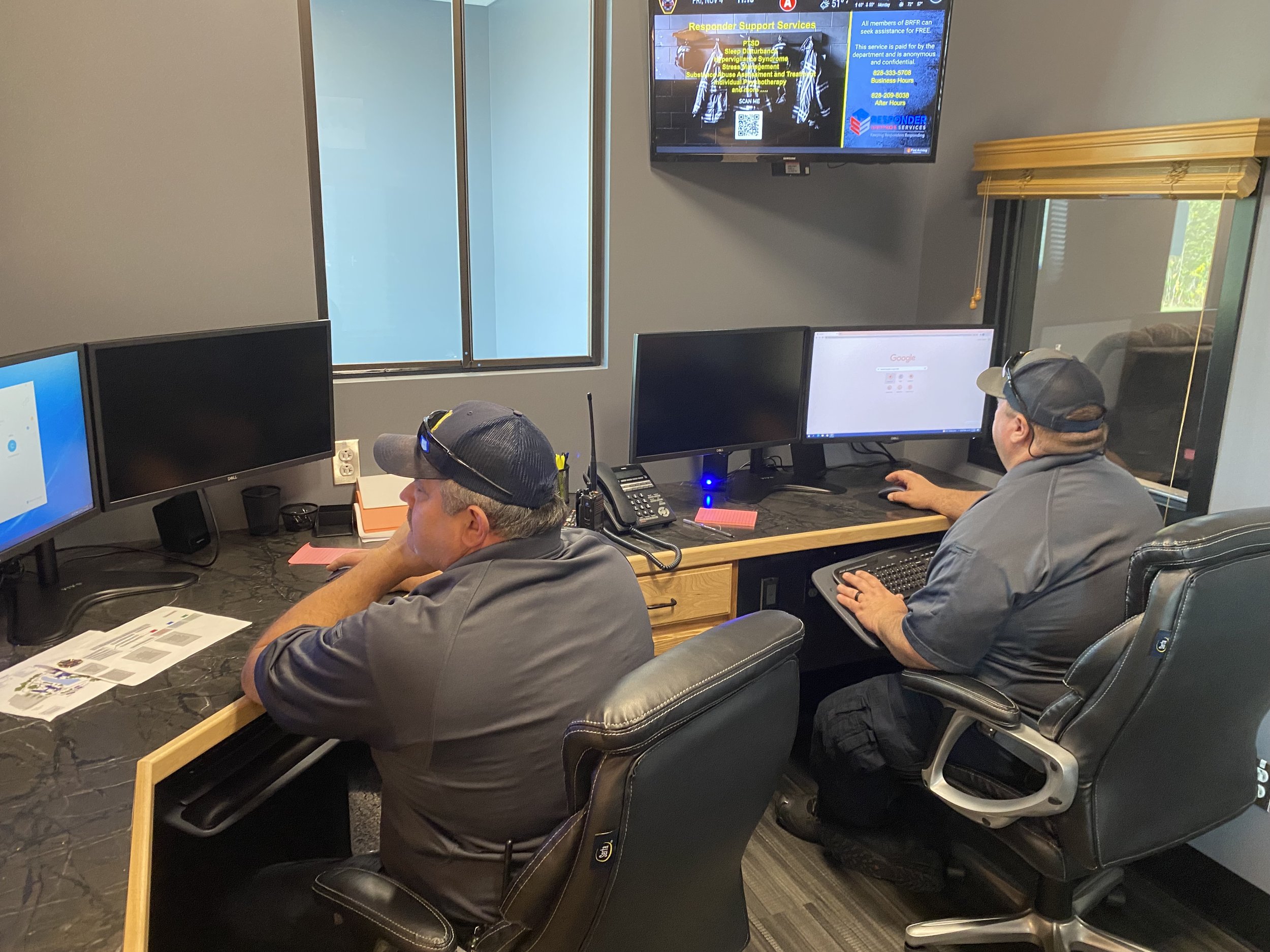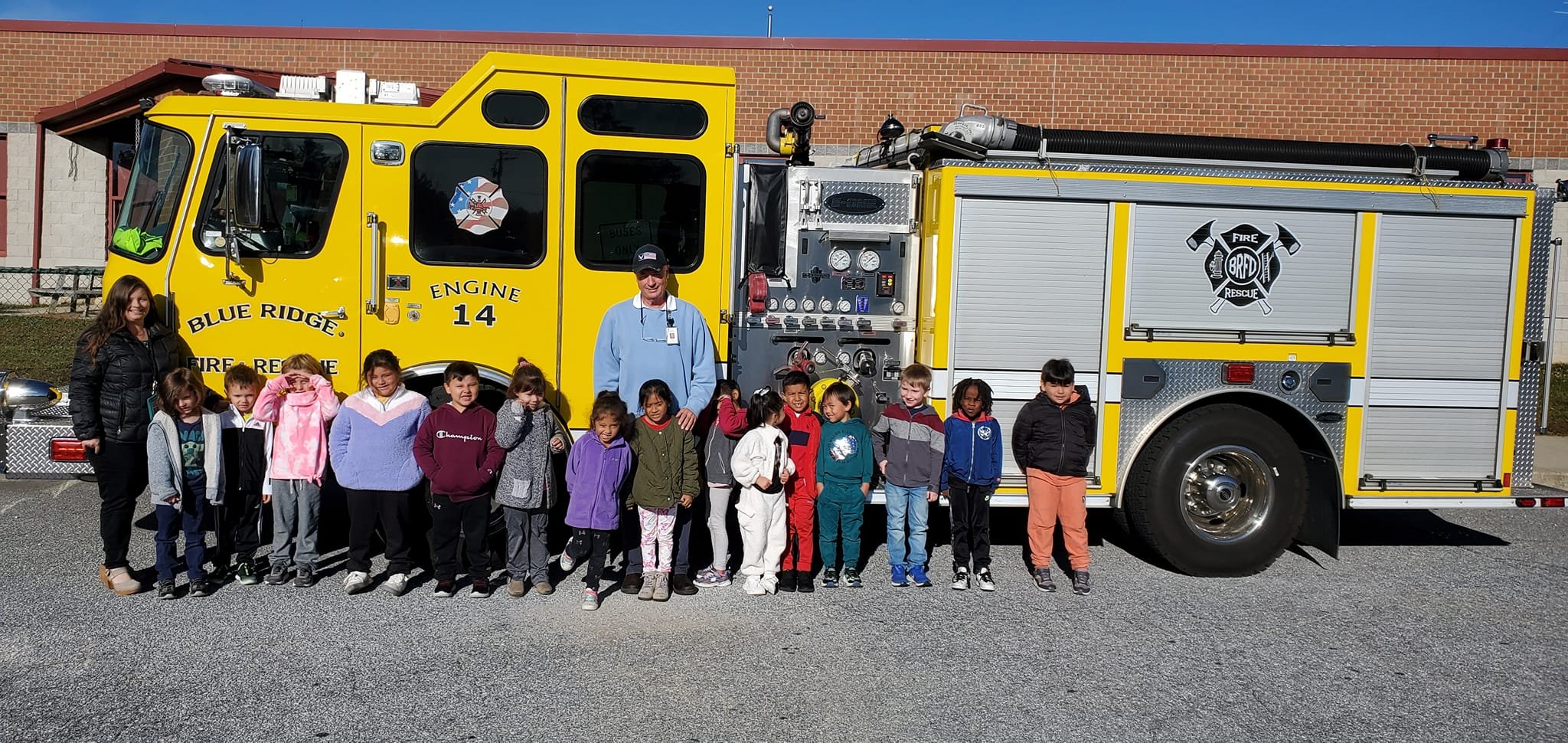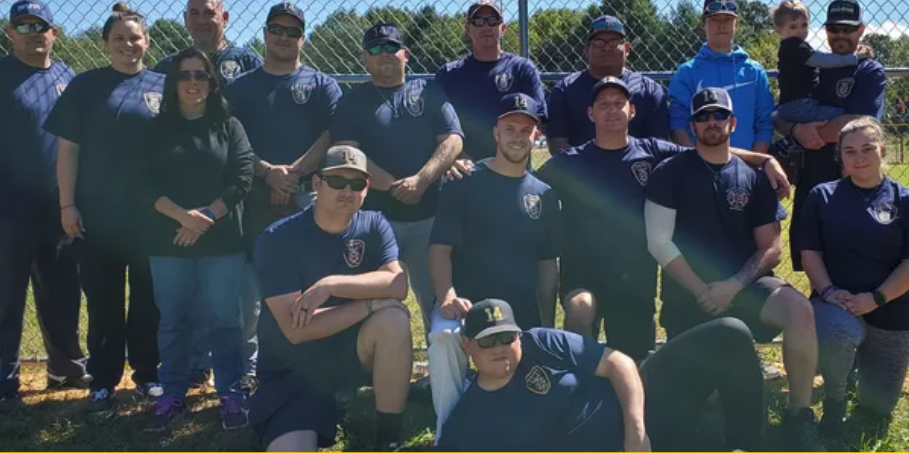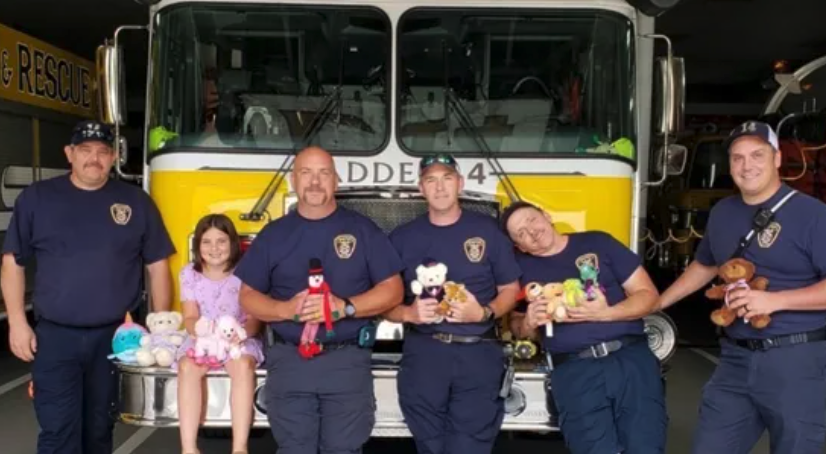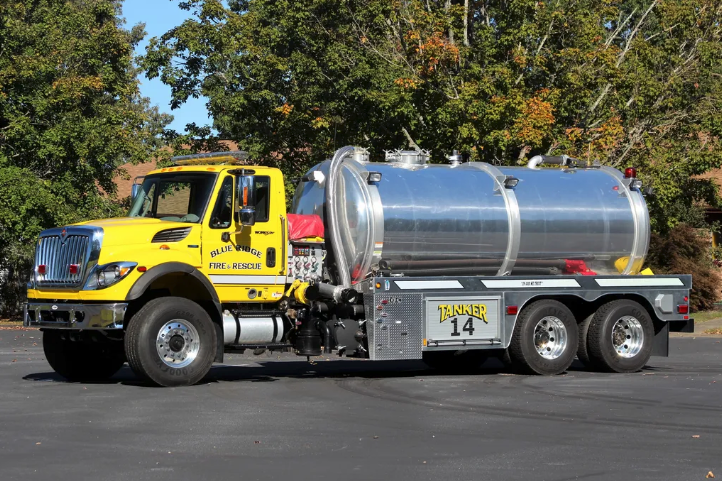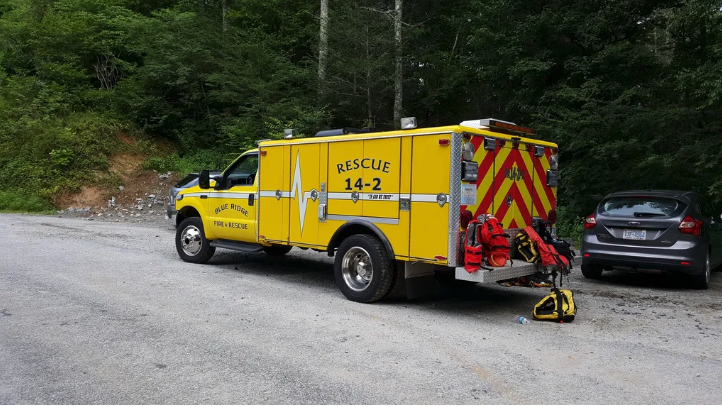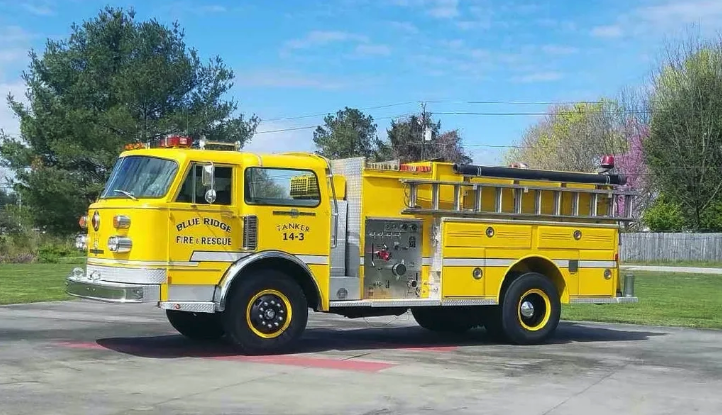To the Rescue
/Members of Blue Ridge Fire and Rescue at Station 2 in Flat Rock
Those of us who live in Flat Rock drive past Blue Ridge Fire and Rescue’s Station #2 almost daily. Sitting adjacent to Village Hall and atop “the Great Flat Rock” that gives the village its name, the old substation was renovated last year to add living quarters. As of February 2022, Station 2 is now the home away from home for the dedicated men and women who are committed to keeping area residents safe, healthy, and protected.
And, although we refer to the employees and volunteers who staff the department as “firefighters,” a closer look at their operation reveals they are much more than just firemen.
—-
Blue Ridge Fire and Rescue (BRFR) was established in 1958 by a small group of volunteers. There was no station at the time so the fire trucks were kept in the yards of volunteers until 1960 when the first firehouse was built at the intersection of Spartanburg Highway (now Old Spartanburg Road) and Crest Road. That station has undergone many renovations since but remains at its original location today.
BRFR in the early Years
A substation was later built on Greenville Highway in the Village of Flat Rock. Designated Station 2, the substation was originally unmanned and used to house equipment operated by firefighters who would drive to the location to take out fire engines and trucks on emergency calls. With the recent renovations, however, Station 2 is now manned 24/7 with a minimum of two personnel at all times. In addition, Station 1 is manned by a minimum of three firefighters at all times.
BRFR is not a government agency and operates as a 501c3 nonprofit that is overseen by a board of directors. BRFR generates revenues for its operations by contracting for its services with Henderson County and the Village of Flat Rock. Village Council member, Matt Toner, appreciates the opportunity to work with BRFR. “We have great respect and gratitude for the hard work all our safety providers give to the village.”
—-
Fire Chief Will Sheehan at BRFR Station 2
Overall, BRFR has a staff of 18 firefighters and a contingent of 25-30 volunteers all led by Fire Chief Will Sheehan. Will became a Junior Firefighter in high school at age 17 and once he got started there was no turning back. “Once it gets in your blood,” he explains, “There’s really nothing else I’d want to do.” Will has been with BRFR for 20 years - the last 4 1/2 years as the Fire Chief.
Of the 18 full-time staff, 15 rotate 24-hour shifts at the two stations. Each shift starts at 8 am and runs until 8 am the next day. Firefighters typically work about 10-12 shifts a month. When emergency calls are received, everyone in the department receives the notification. If the event is large enough to necessitate additional personnel, firefighters who are not on shift will still respond to the call as needed.
BRFR serves an area of approximately 26 square miles with 15-17,000 residents. The service area includes most, but not all, of Flat Rock. The fire district extends south almost to Pinnacle Mountain Road, north to Shepherd Street, west as far as Trenholm Road, and east to Deep Gap Road. The area also covers I-26 from the Peter Guice Bridge over Green River to the Hendersonville exits; Rt 25 south to Exit 7, and SR 176 South to the Green River Bridge.
The parts of Flat Rock not included in that district are covered by the Valley Hill Department to the west and by the Green River Department to the south. The Village of Flat Rock contracts for services from all three departments, but BRFR is the primary provider and is the largest portion of that contract expense.
BRFR has a Mutual Aid agreement with five area departments - Valley Hill, Green River, Saluda, City of Hendersonville, and Dana - and those departments will respond collectively if an emergency event is large enough to require more equipment and personnel than BRFR can supply
BRFR Firefighters in the kitchen of Station 2. (L-R) Deven Dufford, Chris McFarland, and Kenneth Bennison
Renovated Station 2
Having Station 2 online with around-the-clock staffing means faster response times for calls originating from Flat Rock. Chief Sheehan says that response times are typically 3-5 minutes to most areas of the village - perhaps 2-3 minutes faster than engines dispatched from the Old Spartanburg Highway location. And for the types of calls received by BRFR, every second can be critical. “It can mean the difference between a fire that’s contained to one room versus one that spreads throughout a structure,” says Chief Sheehan.
BRFR firefighter Nathan Rush has been with BRFR for 14 years - the first 10 as a volunteer and the last four as a paid firefighter. He and his fellow firefighters appreciate the design of the new building with their sleeping quarters directly adjacent to the engine bays. “We can get out of bed, dressed, and be out the door in 90 seconds,” says Nathan. “And seconds matter. It really makes a difference.”
—-
Ricky Bishop and Nathan Rush in the Office at Station 2.
It is common for people unfamiliar with how the department works to assume that firefighters have a lot of idle time. “Some people think we just come in and sit around waiting for calls, but that’s not the deal here,” says team member Chris McFarland. During a 24-hour shift, firefighters will check equipment, clean trucks, clean the building, complete mandatory physical training, do additional fire and medical training, and a lot of public education events - fire prevention and fire extinguisher classes. They also do pre-planning in area buildings so that they know something about a structure in the event of a fire at that particular location.
And all of those activities are sandwiched between 5-15 calls in a typical day. Bottom line: there’s usually not much time for sitting around.
Area firefighters also frequently work other jobs when not on duty at BRFR. Deven Dufford estimates he works about 80 hours per week between his shifts at BRFR and his additional work with Henderson County Rescue Squad on his “off” days. Just 23 years old, Deven says the long hours are necessary for many firefighters to make ends meet and time at home can be scarce. In his case, however, his fiancé also works in emergency services and understands the sacrifices required to do the job.
Like many of his fellow firefighters, Deven had connections to a local fire department from a young age - the area fire chief lived across the street and recruited Deven as a Junior Firefighter during high school. “Most people who become firefighters grew up around it. Not many people come to the job from ‘off the street.’”
Job training for the fire department is extensive. Paid staff and volunteers are required to achieve state certification before performing their duties. Basic certifications to work with the department are Firefighter, Hazardous Materials, and Emergency Medicine Technician. There are a wide array of other certifications, however, and many of them are taught through the North Carolina Community College system, including Blue Ridge Community College.
If a candidate is willing to go to class full-time they can get their basic certifications in approximately three months. At that point, most firefighters start out as volunteers as they continue to learn the necessary skills and gather valuable experience.
Chief Sheehan says the learning never really stops for his department. “Even with my 30 years of experience, I’m still taking classes and getting certifications.” He adds, “We like to tell the kids that if you want to be a firefighter you need to pay attention in school because that learning process will never end when you’re a firefighter.”
—-
Deven Dufford (L) and Vance Gordon discussing the days activities in one of Station 2’s sleeping quarters.
Volunteers are an essential element of the department. Chief Sheehan estimates that BRFR would need twice as many paid employees to meet the demands if they operated without volunteers. Volunteers can perform any function that a full-time firefighter handles provided they have the necessary certification. Kenneth Bennison has been a volunteer with BRFR for the last 17 years and works full-time as a foreman at a plant in Skyland, NC. But when he’s not at his regular job, he’s usually at BRFR. “I enjoy running calls with the guys. I enjoy being around these guys. It’s like a second home. If I’m off work, I’m here.”
BRFR firefighter Haley Hrabar breaks the stereotype that all firefighters are men. Just 21 years old, Haley has already been with BRFR for four years. First as a Jr. Firefighter in high school, then as a volunteer, and now full-time paid since January of 2022. She was inspired to pursue her career by people who helped her family. “There were a couple of times when first responders helped out my family and seeing them and seeing what they do really made me want to be a light for other people.” She is particularly pleased to be with BRFR now. “It is really rewarding to have a full crew that supports you. I am so happy to be there.”
Calls
The kinds of calls received by BRFR extend far beyond reports of fires. In fact, fires are a relatively small percentage of the calls that come over from the dispatcher. Other types of calls include medical emergencies, rescues, hazardous conditions, traffic accidents, the occasional false alarm and almost any event that requires immediate attention for the safety of the community. Medical emergencies are the most common call and account for more than half of the department’s dispatches.
What they find when they arrive at the scene of a call can vary tremendously. “Everything from nosebleeds and hurt fingers to industrial fires, to search and rescue in the Green River game lands,” says Chris McFarland “You just never know.” They also see a lot of elderly retirees that need assistance - sometimes something as seemingly simple as helping a person get back up after a non-injury fall. According to Chris some folk just need to know that there is someone who is available to help. “They need someone to care and listen to them. I’ve had people cry on my shoulder before because they were so grateful we could help.”
Vance Gordon has worked with fire departments since age 14 and comes from a family of firefighters. His grandfather was a chaplain for the Saluda department. His father is a captain with BRFR and he has a brother who is a firefighter in Polk County. A family history of service in fire departments is a common theme for many in the department. Vance particularly enjoys the variety of situations encountered at BRFR. “We run a very wide array of calls. We run calls for everything you can imagine. And everywhere from the Green River Narrows, to the Interstate, to trailer parks, to Kenmure.” The department averages about 150 calls a month or 2500 per year. BRFR has seen an increase in calls recently and last month BRFR actually responded to 230 calls.
BRFR Ladder Truck
Running a fire department like BRFR is not cheap - even if it is a nonprofit. The typical fire engine costs between $500,000 and $800,000. A full set of turn-out gear for each firefighter can be $7,000 to $8,000. A ladder truck starts at $1,000,000 before accessories and equipment are added. Chief Sheehan explains that the cost is high but the importance of having the right equipment is critical - both to the firefighter and to the residents who are helped by those firefighters. “The cheapest gear doesn’t work because it’s hard to move around in and limits our ability to function.”
At present, BRFR’s fleet includes 15 vehicles including a 95’ ladder truck, four tanker trucks, three fire engines, two rescue trucks, and a quick response vehicle for medical emergencies. Fire engines typically have a useful service life of 20 years.
A Lifestyle
Haley Hrabar
Behind the numbers concerning calls and the cost of equipment, there are men and women who’ve made a decision to take on a very demanding - and often dangerous - job in order to serve their community. And it is a decision that often involves personal sacrifice. Deputy Fire Chief Jerry Hinson felt compelled to become a firefighter after the 9-11 attacks. “If you serve in any kind of capacity in emergency services, it has to be a calling. I feel this is where God has led me.”
His decision also has ramifications for family and loved ones. “I’ve left Christmas meals. Thanksgiving meals. It’s just part of the job.” There is also pressure to perform quickly and effectively under the most difficult of circumstances. “The stakes are really high,” says Jerry. “You have to be on your game when you go out on a call. You don’t want your mistake to be something that involves somebody else’s life.”
Chief Sheehan says that firefighters are far more likely to be seriously injured or killed in traffic accidents - either responding to calls or working at the scene of a traffic accident - than they are to be harmed during fires. Heart attacks are also a serious concern for firefighters as they work in conditions that can be extremely physically taxing.
Given the stresses, the sacrifices, and the very real dangers involved in their job, why do firefighters do it? To a person, it is clear that the men and women at BRFR what to be of service to their community first and foremost. Ricky Bishop has been with BRFR since 1988 and you can still hear his enthusiasm for his job even after 34 years. “I love my job. I look forward to coming to work every day.” He enjoys most the opportunity to help people when they are down. “People call us when they are in their worst times. They are at their bottom and we help bring them back up.”
For Kenneth Bennison, his job also helps put the everyday concerns of life in perspective. “We see people in the darkest times. Anything from a car wreck to a house fire to a medical emergency and it makes you realize how much you’ve got, and how lucky it is that you are the person there to help.”
It’s not all danger and stress. For Nathan, the most rewarding thing is seeing young people get excited about the fire trucks. “I enjoy the little kids. Everybody stops to look at the firetruck. It doesn’t make a difference whether the lights and sirens are going or not.”
(L-r)Nathan Rush, Vance Gordon, Ricky Bishop, Deven Dufford, Jerry Hinson, Kenneth Bennison, Will sheehan, and Chris McFarland.
Ultimately, the thing that most closely bonds the men and women of BRFR is the very real sense that they are brothers and sisters working for a common cause. “It’s family,” Nathan explains. “When you are in need, they are there for you. They will call to check on you. Help you financially. They’ll do anything for you.”
—-
The mission statement for Blue Ridge Fire and Rescue is “Community First” - a sentiment that perfectly represents the men and women of the department. We may not know their names and few of us would recognize their faces out in public, but they know us and they are ready - 24 hours a day - to help us when we need it most. “We’re really happy to be here,” says Chief Sheehan. “And we have a crew that is absolutely committed to providing great service to the community.”
That’s a very good thing to know. Thank you, Blue Ridge Fire and Rescue.
—-
Learn more at https://blueridgefire.com/




